In 1877, Western Union decided to compete with Bell and began the commercial production of telephones. George Phelps patented inventions in both telephone receiver and transmitter designs. Western Union conducted extensive tests with the telephone designs of Phelps,
Edison, and Elisha Gray. (Gray was an electrician, inventor, and co-founder of the Western Electric Mfg.Co.
in Chicago.) The telephones that were built by Bell, Gray, and Phelps utilized a magneto design.
A magneto telephone could be used as either a receiver or a transmitter. A user would speak into the magneto telephone, then quickly move the phone to his ear to listen.
On short lines the magneto worked satisfactory, but as a transmitter on long lines,
its output was too weak.
Early telephones were connected using existing telegraph lines and were often subject to interference from adjacent lines.
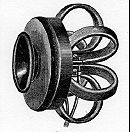 Thomas Edison invented a carbon transmitter to solve the problems of the magneto.
Western Union evaluated Edison's Carbon Telephone Transmitter in a test between New York and Philadelphia, early in 1878. Present for the evaluation in Philadelphia was Charles Batchelor, Edison's chief assistant. In New York, William Orton, (W.U. president) Thomas Edison, and George Phelps were present.
It was determined that Edison's Carbon Telephone was superior to the magneto as a transmitter and thus became the standard transmitter used by Western Union. The receiver that was commonly used was the Phelps Single Crown Telephone, shown on the right.
Thomas Edison invented a carbon transmitter to solve the problems of the magneto.
Western Union evaluated Edison's Carbon Telephone Transmitter in a test between New York and Philadelphia, early in 1878. Present for the evaluation in Philadelphia was Charles Batchelor, Edison's chief assistant. In New York, William Orton, (W.U. president) Thomas Edison, and George Phelps were present.
It was determined that Edison's Carbon Telephone was superior to the magneto as a transmitter and thus became the standard transmitter used by Western Union. The receiver that was commonly used was the Phelps Single Crown Telephone, shown on the right.
Western Union marketed their telephones through their subsidiaries : The American Speaking Telephone Company and The Gold and Stock Telegraph Company.
They sold telephones utilizing Edison's Carbon Telephone as the transmitter paired with Phelps' Single Crown Telephone as the receiver.
Gray's telephone was also paired with the Edison transmitter.
Western Union's New York factory, run by Phelps,
would build both telegraph and telephone apparatus 1877 through 1879.
Two examples of phones built by Phelps in his factory are shown below illustrating the Edison/Phelps combinations. The carbon buttons used in the manufacture of Edison's transmitters,
were supplied to Phelps directly by Edison from Menlo Park.
In late 1879 Western Union and Bell settled on a patent infringement suit filed by Bell.
In the settlement, Western Union sold to Bell,
its telephone exchanges in 55 cities and 56,000 subscriber telephones.
The phone on the right also shows an "ordinary" Phelps telegraph sounder being used as the bell.

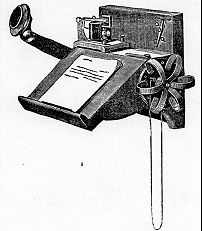
and Stock Telegraph Company in February of 1878. The instruments selected for use were
the Edison Carbon Telephone and the Phelps Crown Telephone.
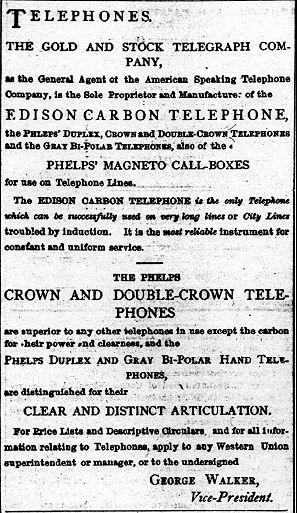
A copy of a 1878 ad by The Gold and Stock
Telegraph Co.. All the telephone instruments
in this ad, with the exception of Elisha Gray's
Bi-Polar, were built in the Phelps/Western Union
Manufactory.
Smithsonian Photos
Photos and Descriptions of some of Phelps' Telephones
Photos courtesy of The Smithsonian Institution-National Museum of American History
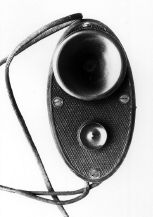
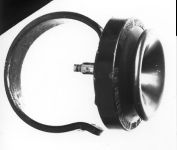
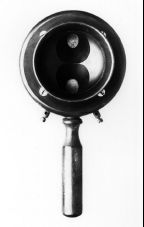
Left Duplex MagnetoTelephone
Center "Crown" Telephone Series
Right Dual Magneto Telephone Transmitter

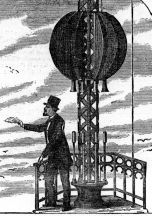
Beginning in September of 1877, two million area New Yorkers had the ability to set their time pieces to
an event that happened daily at noon. High a top Western Union's headquarters at 195 Broadway in New York
City, a ball dropped precisely at noon triggered via telegraph by a operator at the National
Observatory in Washington. Western Union's ten story building at that time was the tallest building in New York (and in the U.S.). People could view the ball dropping from several miles around. This system, including the ball and discharging apparatus,
was designed and built by George Phelps. The initial time reference used to start "Standard Railway Time" in the U.S. began with the dropping of Western Union's Time Ball in 1883. The Time Ball would remain in use until 1913 when its view was beginning to be obstructed by New York's growing sky line.

Click here for a description of its operation
and more photos of the Western Union Time Ball
To page 5 of 6
Back to first page